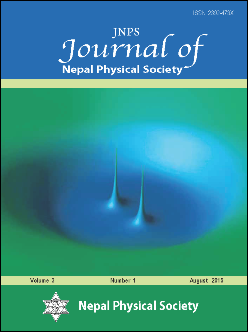Polar Cap Potential and Merging Electric Field during High Intensity Long Duration Continuous Auroral Activity
DOI:
https://doi.org/10.3126/jnphyssoc.v3i1.14437Keywords:
Magnetosphere, polar cap potential, HILDCAAs, wavelet analysisAbstract
The polar cap potential (PCV) has long been considered as a key parameter for describing the state of the magnetosphere/ionosphere system. The relationship between the solar wind parameters and the PCV is important to understand the coupling process between solar wind-magnetosphere-ionosphere. In this work, we have estimated PCV and merging electric field (Em) during two different high intensity long duration continuous auroral activity (HILDCAA) events. For each event, we examine the solar wind parameters, magnitude of interplanetary magnetic field (IMF), interplanetary electric field (IEF), PCV, Em and geomagnetic indices (i.e., SYM-H, geomagnetic auroral electrojet (AE) index, polar cap index (PCI) and auroral electrojet index lower (AL), respectively). We also study the role of PCI and AL indices to monitor polar cap (PC) activity during HILDCAAs. In order to verify their role, we use wavelet transform and cross-correlation techniques. For the three events studied here, the results obtained from continuous wavelet transform (CWT) and discrete wavelet transform (DWT) are different, however the effect of HILDCAA can be easily identified. We also observe the cross-correlation of PCI and PCV with AL, SYM-H, Bz component of the IMF and Ey component of the IEF individually. Both PCI and PCV show very good correlation with AL and SYM-H indices during the events. Observing these results, it can be suggested that PCI and AL indices play a significant role to monitor geomagnetic activity generated by geoeffective solar wind parameters.
Journal of Nepal Physical Society Vol.3(1) 2015: 6-17
Downloads
Downloads
Published
How to Cite
Issue
Section
License
All right reserved. No part of this Journal may be reproduced in any form or by any electronic or mechanical means, including information storage and retrieval system, without permission in writing from the publisher, except by a reviewer who may quote brief passage in a review. The views and interpretation in this journal are those of author(s) and they are not attributable to the NPS.




